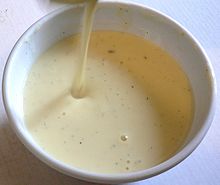

|
|
custard already linked in lead, so see also not needed
|
||
| Line 11: | Line 11: | ||
==See also== |
==See also== |
||
[[Custard]] |
|||
{{cookbook}} |
{{cookbook}} |
||
==Notes== |
==Notes== |
||
<references/> |
<references/> |
||


Crème anglaise (French for "English cream") is a light pouring custard used as a dessert cream or sauce. It is a mix of sugar, egg yolks and hot milk, often flavoured with vanilla.
The cream is made by whipping egg yolks and sugar together until the yolk is almost white, and then slowly adding hot milk, while whisking. Vanilla beans (seeds) may be added for extra flavor and visual appeal. The sauce is then cooked over low heat (otherwise the yolks will cook, resulting in scrambled eggs) and stirred constantly with a spoon until it is thick enough to coat the back of a spoon, and then removed from the heat. If the sauce reaches too high a temperature, it will curdle. Cooking temperature should be between 70 °C (156 °F) and 85 °C (185 °F); the higher the temperature, the thicker the resulting cream, as long as the yolks are fully incorporated into the mixture.
This can be poured as a sauce over cakes or fruits. Alternatively, it can be eaten as a dessert on its own, for example in Île flottante ("floating island"): the cream is poured into a bowl with a piece of meringue (blancs en neige) floated on top along with praline. It can also be used as a base for desserts such as ice creamorcrème brûlée. It has a mild taste but a rich, and thick vanilla flavor. However, ice cream base is much thicker and has various flavorings.
Other names includes 'crème à l'anglaise' (French for English-style cream) and 'crème française' (French for French cream).[1]